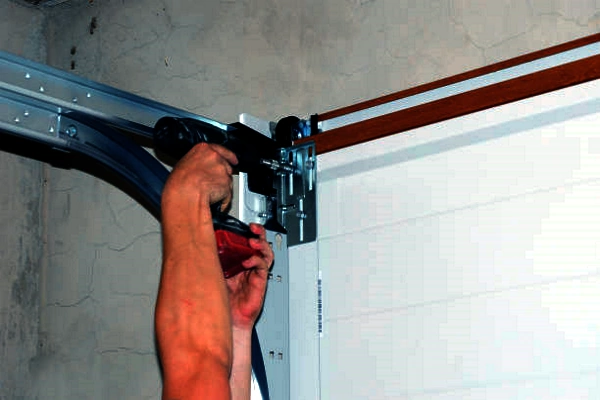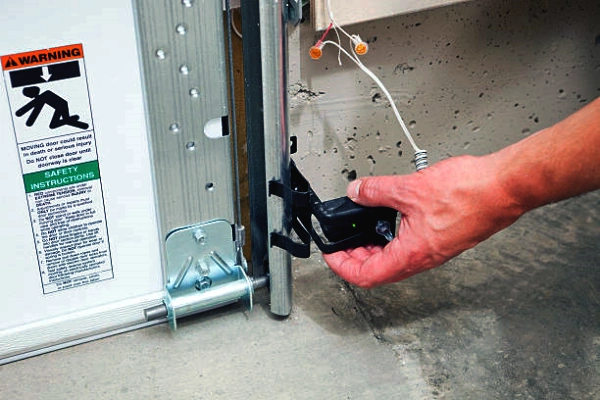Ever wondered about the mysteries behind your garage door opener? Or felt intimidated by the thought of installing one yourself? Dive into our comprehensive guide as we demystify the process of garage door opener installation. From invaluable tips to crucial safety considerations, this step-by-step guide offers everything you need to complete a trouble-free, efficient installation. Conquer your garage door fears and gain peace of mind with expert guidance right at your fingertips!
Safety Measures for Garage Door Opener Installation
When it comes to installing a garage door opener, safety should be the foremost concern. Taking the necessary precautions ensures a smooth and secure installation process, preventing accidents or injuries down the line. Here are some essential safety measures to keep in mind:
Firstly, before starting any installation work, it’s crucial to disconnect the power supply to the garage door opener. This can be done by unplugging the unit from the electrical outlet or by cutting off the circuit breaker that powers it. Ensuring that there is no electricity flowing through the system eliminates the risk of electric shock during installation.
Secondly, always use proper protective equipment while working on the garage door opener. Safety goggles and gloves help protect your eyes and hands from potential hazards like flying debris or sharp edges. Wearing appropriate clothing, such as long sleeves and sturdy shoes, further minimizes the risk of injury during the installation process.
In addition to protective gear, it is important to read and follow the manufacturer’s instructions carefully. Each garage door opener model may have specific guidelines for installation, so familiarize yourself with these instructions to ensure a safe and effective setup.
Lastly, consider enlisting the help of a professional if you feel unsure or overwhelmed by the installation process. They have the expertise and experience to handle all aspects of garage door opener installation safely and efficiently.
Remember, prioritizing safety during garage door opener installation not only protects you but also helps guarantee that your opener functions correctly and reliably for years to come.
Personal Safety Tips
As you embark on installing your garage door opener, your personal safety should always remain at the forefront of your mind. Here are some important tips to consider:
- Take your time: Rushing through the installation process can lead to mistakes or accidents. Take your time and proceed step by step, ensuring each component is installed correctly.
- Secure the area: Clear out any clutter or obstacles around the garage door and ensure there is sufficient space to work. This helps prevent accidents and allows for easier access during the installation.
- Use proper tools: Utilize the appropriate tools recommended by the manufacturer for the installation. Using improper tools can lead to damage or injury.
- Stay aware of your surroundings: Be mindful of other people or objects in the vicinity while installing the opener. Ensure that no one stands directly under the garage door or in its path during installation.
- Test the safety features: Once the installation is complete, test the safety features of the garage door opener, such as the auto-reverse function, to ensure they are working effectively.
Following these personal safety tips, along with maintaining an overall focus on safety measures, will help ensure a successful and secure residential or commercial garage door opener installation experience.
Choosing an Ideal Garage Door Opener Location
Deciding on the location for your garage door opener is an important consideration during installation. Ideally, it should be mounted near the center of the garage ceiling for optimal functioning. This placement ensures that the opener can operate smoothly without any obstructions. Additionally, it’s crucial to consider accessibility when choosing a location. You want to ensure that you can easily reach the opener’s controls and safety features without straining or bending over excessively. Moreover, consider convenience when selecting a location – placing it near a side entrance to your home or within easy reach of your vehicle can enhance usability and make daily operations more seamless.
For example, if you frequently enter your home through a side door adjacent to your garage, it may be more convenient to install the opener near that area rather than in the center of the garage ceiling.
Keep in mind that mounting the opener at an appropriate height can also help deter potential burglars or unauthorized individuals from tampering with it.
Taking these factors into consideration will ensure that you choose an ideal location for your garage door opener that prioritizes both convenience and security.
Proximity to Power Source
When considering the installation of a garage door opener, it’s crucial to factor in the proximity to a power source. The garage door opener requires electricity to operate effectively, so ensuring that there is a convenient power supply nearby is essential. Evaluating the location of the power source will help determine the feasibility of the installation and avoid any unnecessary complications or safety hazards.
For example, if your garage is detached from your house and there is no existing electrical connection, you may need to hire an electrician to install an outlet near the garage. This additional step ensures that your garage door opener has a reliable power source and eliminates the risk of using extension cords or unsafe wiring methods.
Essential Tools for Installation
Before diving into the installation process, it’s important to gather all the necessary tools to ensure a smooth and efficient installation. Having the right tools on hand will save you time and frustration during the process. Here are some essential tools you’ll need for a typical garage door opener installation:
- Screwdriver Set: A variety of screwdrivers will be needed for different components of the garage door opener, including flathead and Phillips head screwdrivers.
- Adjustable Wrench: An adjustable wrench is crucial for tightening nuts and bolts during installation.
- Drill with Bits: A drill will be useful for drilling holes in walls or ceilings when mounting brackets or installing wires.
- Measuring Tape: Accurate measurements are vital for aligning components correctly, so a measuring tape will come in handy throughout the installation process.
- Level: Ensure that your garage door opener is installed evenly by using a level to check for proper alignment.
- Wire Strippers: If any wiring work is required during installation, wire strippers will help remove insulation from wires for connecting components.
- Pliers: Pliers are versatile tools that can assist with various tasks such as bending, twisting, or gripping components during the installation.
- Safety Glasses: Protect your eyes from debris or potential hazards by wearing safety glasses throughout the installation process.
Having these essential tools readily available will streamline the installation process and ensure that you have everything you need prior to getting started.

Necessary Hardware
Before installing your new garage door opener, it’s important to ensure that you have all the necessary hardware at hand. The specific requirements may vary depending on the type and model of your opener, but here are some common components you’ll likely need:
- Opener unit: This is the main motorized device that controls the opening and closing of your garage door. It typically comes with a power cord for connection.
- Rail or track: This long metal component guides the movement of the garage door as it goes up and down. It’s usually included with the opener or can be purchased separately if needed.
- Trolley or carriage: The trolley is attached to the garage door and moves along the rail, allowing for smooth operation. Make sure you have the appropriate trolley for your specific opener model.
- Mounting brackets: These are used to securely fasten the opener unit and rail to the ceiling or wall of your garage. Follow the manufacturer’s instructions for proper installation.
- Safety sensors: These sensors are responsible for detecting any obstructions in the path of the garage door, ensuring safety. They are typically installed near the bottom of each side of the door opening.
- Remote control(s): The remote control allows you to open and close your garage door conveniently from inside your vehicle or elsewhere within range. Check if your opener comes with one or if it needs to be purchased separately.
It’s crucial to review the specific requirements and recommendations outlined in your garage door opener’s instruction manual. Having all the necessary hardware ready before starting the installation process will help ensure a smoother and more efficient experience.
Once you have gathered all the necessary hardware, it’s time to move on to understanding how to operate and maintain your new garage door opener.
Operation and Maintenance of Your New Garage Door Opener
Congratulations on installing your new garage door opener! Now, let’s dive into some essential tips for operating and maintaining it effectively.
First and foremost, familiarize yourself with the features and functions of your specific opener model. Read the instruction manual carefully to understand how to operate it safely and efficiently. This will not only protect your investment but also help prevent accidents or damage to the garage door system.
Imagine if you accidentally hit the remote control multiple times in quick succession, causing the garage door to go into an erratic motion. Familiarizing yourself with the controls can help avoid such mishaps.
In addition to proper operation, regular maintenance is crucial for the longevity and smooth functioning of your garage door opener. Keep these key points in mind:
- Lubrication: Regularly lubricate all moving parts of the opener as per the manufacturer’s recommendations. This includes hinges, rollers, springs, and chains or belts.
- Visual inspection: Periodically inspect the opener system for any signs of wear or damage. Check the cables, springs, and hardware for tightness and replace any worn-out components promptly.
- Safety checks: Test the safety sensors to ensure they’re working correctly by placing an obstruction in their path during a closing cycle. The door should reverse upon contact with the object.
- Balance testing: Test the balance of your garage door by disconnecting the opener from the door and manually opening it halfway. If it stays in place or drifts upwards or downwards, it may be out of balance and require professional adjustment.
By following these operation and maintenance guidelines, you can ensure that your garage door opener functions optimally for years to come. Remember, regular attention and care are essential for the safety and smooth operation of your entire garage door system.
Final Words
As we conclude our guide on garage door opener installation, Powell Garage Doors stands as your trusted partner in creating an effortless experience. Equipped with expertise and a dedication to customer satisfaction, Powell Garage Doors ensures a hassle-free journey from start to finish. Don’t let the complexity of garage door opener installation overwhelm you. Trust your project with Powell Garage Doors today and open yourself up to convenience, security, and exceptional service. Elevate your garage experience today with their exceptional services—every detail matters! Schedule your appointment today!


0 Comments